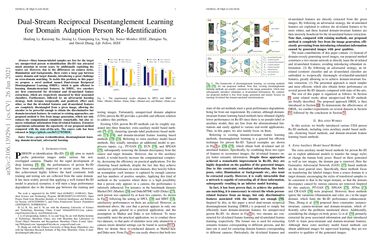Dual-Stream Reciprocal Disentanglement Learning for Domain Adaptation Person Re-Identification
Since human-labeled samples are free for the target set, unsupervised person re-identification (Re-ID) has attracted much attention in recent years, by additionally exploiting the source set. However, due to the differences on camera styles, illumination and backgrounds, there exists a large gap between source domain and target domain, introducing a great challenge on cross-domain matching. To tackle this problem, in this paper we propose a novel method named Dual-stream Reciprocal Disentanglement Learning (DRDL), which is quite efficient in learning domain-invariant features. In DRDL, two encoders are first constructed for id-related and id-unrelated feature extractions, which are respectively measured by their associated classifiers. Furthermore, followed by an adversarial learning strategy, both streams reciprocally and positively effect each other, so that the id-related features and id-unrelated features are completely disentangled from a given image, allowing the encoder to be powerful enough to obtain the discriminative but domain-invariant features. In contrast to existing approaches, our proposed method is free from image generation, which not only reduces the computational complexity remarkably, but also removes redundant information from id-related features. Extensive experiments substantiate the superiority of our proposed method compared with the state-of-the-arts. The source code has been released in https://github.com/lhf12278/DRDL.
PDF Abstract





 Market-1501
Market-1501
 DukeMTMC-reID
DukeMTMC-reID